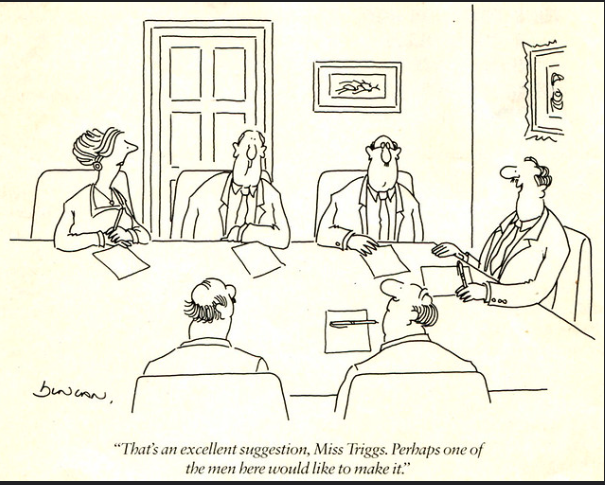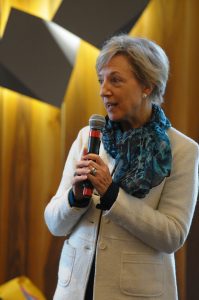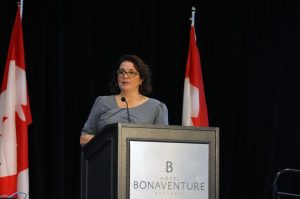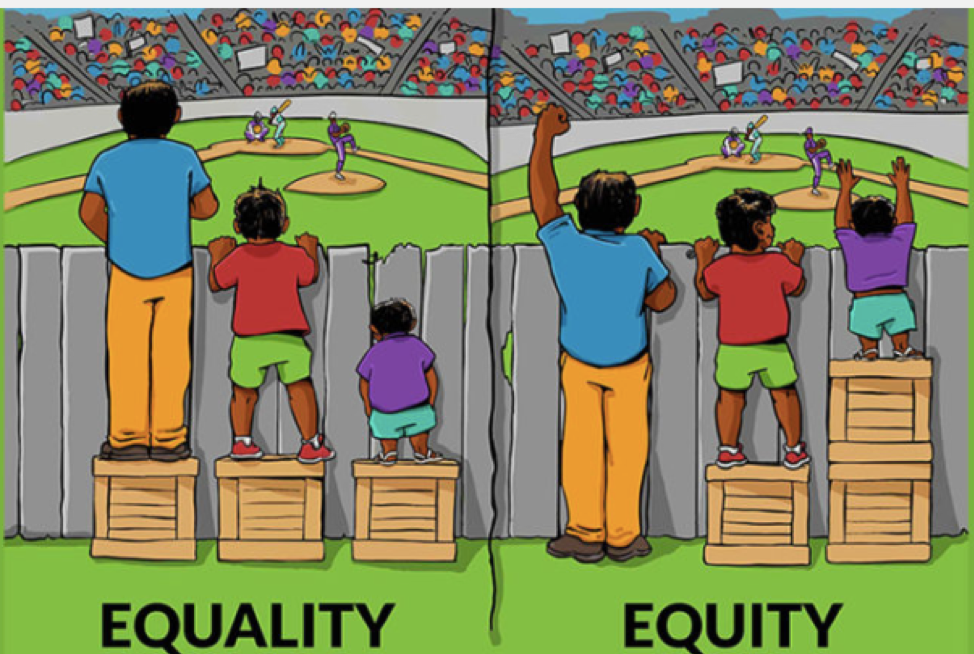

Shari Graydon, Founder of Informed Opinions, speaking at the 2019 Till & McCulloch Meetings
This cartoon from 1988, drawn by Riana Duncan for Punch, was included in a talk titled “In Search of the Lehman Sisters: Why Your Insights are Needed,” by Shari Graydon, Founder of Informed Opinions, at a “Women in Regenerative Medicine Luncheon” at the 2019 Till & McCulloch Meetings (TMM 2019) in Montreal. The message it conveys perfectly sums up why Shari Graydon is passionate about giving voice to women. Note that, sadly, this is still a pressing and relevant issue 30 years later.
Ms. Graydon used her time to remind the (mostly) women scientists in the room to take advantage of every opportunity to share their considerable knowledge and expertise. She explained that men who are invited to give expert commentary typically do so willingly and enthusiastically while women often defer to others out of a belief that someone else knows more about the topic at hand.
Informed Opinions has a practical solution to reducing the imbalance between the number of male and female experts quoted by journalists and invited to speak at conferences. First, there is the Expert Database. Wondering if you qualify? Review the Anatomy of an Expert then join or nominate someone else. The participation of women in the database helps raise the profile of a demographic whose voices are often overlooked. As Ms. Graydon stated at the close of her session, putting yourself out there isn’t just about gaining attention for yourself. It also normalizes the situation for others. Do this for the generations who will follow you (see #6 below).
Ms. Graydon shared six strategies to activate women’s voices in society. They are:
- Speak up and be seen. It’s not about who you know, it’s who knows you.
- Be strategic about your purpose and impact. When meeting someone new, go beyond the “business card” introduction. Say what you do – your purpose/the problem you solve – rather than simply stating your title and the name of the organization where you work.
- Know your value.
- Promote best practices/solutions in equity, diversity and inclusion. More on this below.
- Leverage allies and echoes. Bring your allies; hire for diversity. Be sure to echo when an ally makes a good point. Show your support. Others will notice when many voices are amplifying the same ideas.
- Make it about something bigger than yourself.

Kelly Nolan, Founder of Talent Strategy, speaking at the 2019 Till & McCulloch Meetings
This luncheon followed a plenary session earlier the same day from Kelly Nolan, Founder of Talent Strategy, who gave a presentation on “How to think and work inclusively: Breaking the exclusion habit.”
The two presentations complemented each other very nicely. Ms. Nolan spoke about equity, diversity and inclusion (EDI) – something that is sorely lacking in the comic above – and unconscious bias. Unconscious bias fuels inequity, non-diversity and exclusion, while EDI promotes fostering more “just” workplaces.
Because of unconscious bias, EDI requires a great deal of effort to promote and instill in an organization. It is difficult to overcome your own social stereotypes, especially if you’ve lived with them your whole life or your entire professional career. Having these biases do not necessarily make you a bad person, but ignoring them might. Ms. Nolan was upfront that, during her career in public relations, she typically hired women because of a belief that men couldn’t multitask and therefore were incapable of performing well. Take a moment to think about what biases you hold in the workplace.
And here’s why EDI matters. According to a Forbes article by Laura Berger, McKinsey’s Delivery Through Diversity report shows “companies with the most ethnically diverse executive teams are 33 per cent more profitable.” Ms. Berger also writes that “A Catalyst study found that companies with more women in executive positions have a 34 per cent higher return to shareholders than those that do not. What’s more, companies with the most women directors have a 26 per cent higher return on invested capital than those with the least. And 37 per cent of surveyed employees believe that gender diversity means better business results.”
If you think EDI isn’t relevant to science, the Union of Concerned Scientists (UCS) believes “science should be a means – and not an obstacle – to reducing racial and economic inequality and ensuring that science-based policy decisions benefit all.”
The UCS appears to be leading by example. It states: “Science Network staff are still learning about how best to do our part in supporting more equitable participation and opportunity in science advocacy and addressing the additional inequalities and pressures that underrepresented scientists face as they pursue their education and career. We are more likely to develop just solutions by tapping into the skills, talents, and experiences that people of different races, ethnicities, sexual orientations, genders, and economic classes bring.”
A pilot program, launched by the Natural Sciences and Engineering Research Council of Canada, lists 17 Canadian colleges and universities that will collect EDI data and collaboratively develop “an action plan with goals based on identified gaps, barriers and trends.” If it is successful, and adopted at post-secondary institutions across the country, we may begin to see change happen in a meaningful and observable way.
I’ll end with this image from the Independent Sector that illustrates why equity matters and how it differs from equality. Further, the image underscores that it’s acceptable to put accommodations in place to achieve equity.
What are you doing to ensure more equity, diversity and inclusion exists in your workplace? Please comment below or on Twitter, tagging @Signalsblogs. (You can also tag @CCRM_ca on Twitter and Instagram, or find us on LinkedIn and Facebook.)
Watch Signals for coverage of some scientific talks from TMM 2019, coming soon.

Stacey Johnson
Latest posts by Stacey Johnson (see all)
- Right Turn: Beyond the ’stache: The science, the progress, the promise - November 26, 2025
- Right Turn: Can Bryan Johnson live forever? Will regenerative medicine help him do so? - October 10, 2025
- Right Turn: #pinksocks, diabetes news and other ramblings - June 24, 2025






Comments